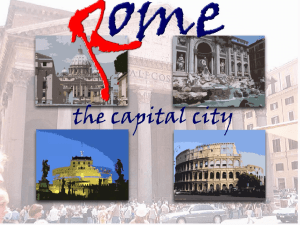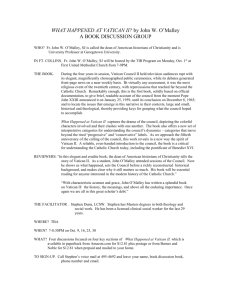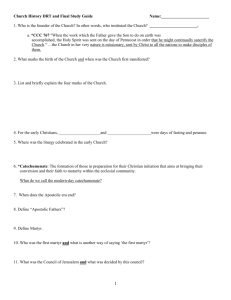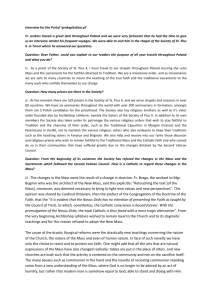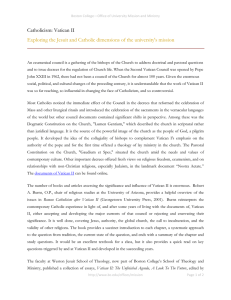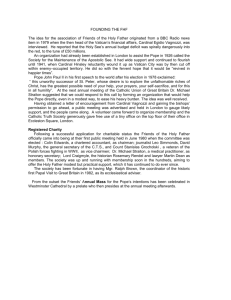Vatican II Revisited
advertisement
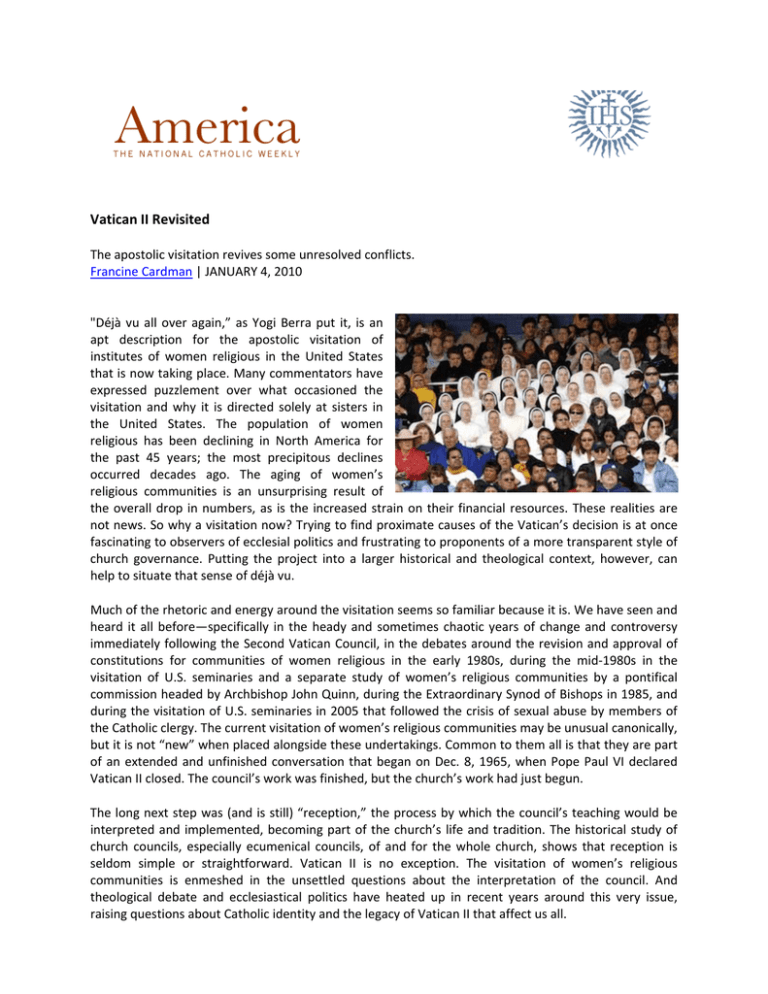
Vatican II Revisited The apostolic visitation revives some unresolved conflicts. Francine Cardman | JANUARY 4, 2010 "Déjà vu all over again,” as Yogi Berra put it, is an apt description for the apostolic visitation of institutes of women religious in the United States that is now taking place. Many commentators have expressed puzzlement over what occasioned the visitation and why it is directed solely at sisters in the United States. The population of women religious has been declining in North America for the past 45 years; the most precipitous declines occurred decades ago. The aging of women’s religious communities is an unsurprising result of the overall drop in numbers, as is the increased strain on their financial resources. These realities are not news. So why a visitation now? Trying to find proximate causes of the Vatican’s decision is at once fascinating to observers of ecclesial politics and frustrating to proponents of a more transparent style of church governance. Putting the project into a larger historical and theological context, however, can help to situate that sense of déjà vu. Much of the rhetoric and energy around the visitation seems so familiar because it is. We have seen and heard it all before—specifically in the heady and sometimes chaotic years of change and controversy immediately following the Second Vatican Council, in the debates around the revision and approval of constitutions for communities of women religious in the early 1980s, during the mid‐1980s in the visitation of U.S. seminaries and a separate study of women’s religious communities by a pontifical commission headed by Archbishop John Quinn, during the Extraordinary Synod of Bishops in 1985, and during the visitation of U.S. seminaries in 2005 that followed the crisis of sexual abuse by members of the Catholic clergy. The current visitation of women’s religious communities may be unusual canonically, but it is not “new” when placed alongside these undertakings. Common to them all is that they are part of an extended and unfinished conversation that began on Dec. 8, 1965, when Pope Paul VI declared Vatican II closed. The council’s work was finished, but the church’s work had just begun. The long next step was (and is still) “reception,” the process by which the council’s teaching would be interpreted and implemented, becoming part of the church’s life and tradition. The historical study of church councils, especially ecumenical councils, of and for the whole church, shows that reception is seldom simple or straightforward. Vatican II is no exception. The visitation of women’s religious communities is enmeshed in the unsettled questions about the interpretation of the council. And theological debate and ecclesiastical politics have heated up in recent years around this very issue, raising questions about Catholic identity and the legacy of Vatican II that affect us all. What Happened at Vatican II? If it seems far‐fetched to place the visitation in this seemingly abstruse context, consider an article in L’Osservatore Romano (1/28/09). Entitled “From Past to Present: Religious Life Before and After Vatican II,” it is a slightly revised version of an address given by Cardinal Franc Rodé, prefect of the Congregation for Institutes of Consecrated Life and Societies of Apostolic Life, at a conference on apostolic religious life the previous fall at Stonehill College in Massachusetts. The speech reveals some of the presuppositions and the implicit agenda of the visitation, which is under the direction of his office. Cardinal Rodé characterizes the decades since Vatican II as a period in which “the church has undergone one of her greatest crises of all times,” and he notes that “the dramatic situation of consecrated life has not been marginal to this state of affairs.” He attributes what he considers the sorry state of religious life to inauthentic renewal based on a profoundly misguided interpretation of Vatican II. Labeling this mistaken approach a “hermeneutics of discontinuity and rupture,” the cardinal decries the “pseudo‐ aggiornamento” that followed, which he describes as centered on humankind rather than on God, a turn toward “naturalism” and away from “the supernatural.” As a corrective he proposes a “hermeneutics of continuity and reform” that is “in the true spirit of the council.” That true spirit is to be found and followed, he concludes, in “what John Paul II taught us yesterday and what Benedict is teaching us today.” That there are serious, ongoing differences about the meaning of the council is not surprising. Some of the same interpretive issues have played out in the pages of this magazine in exchanges between two Jesuit scholars, John W. O’Malley, a church historian, and the late Cardinal Avery Dulles, a systematic theologian. In its most basic form, what is at issue is change: Did anything happen at Vatican II that changed the way the church thinks, speaks and acts? Father O’Malley argues that something new did happen, that the council taught by its words and its own actions a different way of being church. In order to understand the council, he suggests, it is necessary to acknowledge and attend to its discontinuities as well as to its continuities with church tradition and to learn from both. Cardinal Dulles argues that although there were some elements of change in the council’s work and style, there were no substantive changes in teaching. What change there was must be understood from the perspective of, and subordinated to, an essential continuity with the church’s tradition. In that sense, nothing new happened at the council; contrary claims reflect a myth rather than the reality of Vatican II. In Cardinal Rodé’s terms, Father O’Malley’s interpretation would exemplify a “hermeneutics of discontinuity and rupture,” Cardinal Dulles’s a “hermeneutics of continuity and reform.” Both characterizations are unfair. These interpretive differences are now being replayed in relation to the visitation. The question of change underlies Cardinal Rodé’s criticism of women’s apostolic religious communities and what he considers the erroneous interpretation of Vatican II that guided them in their renewal process. A common thread links the cardinal’s remarks with papal and curial efforts to establish an interpretation of the council and promote a vision of Catholic life that restores something like the pre‐Vatican II church. A developing agenda for “authentic” interpretation of the council can be discerned early in John Paul II’s pontificate, when he convened an Extraordinary Synod of Bishops in 1985 for the “celebration, verification [my emphasis], and promotion” of Vatican II on the 20th anniversary of its closing. To that end, the papal report on the synod identified six interpretive norms for reading the council’s documents, principles to which Cardinal Dulles appealed and Father O’Malley also subscribed, but with qualifications about how these norms themselves should be interpreted and applied. A decade later, the pope outlined his agenda for the renewal of religious life in Vita Consecrata, his report summing up the 1996 Synod on Consecrated Life. There Pope John Paul II makes a telling observation on the work of the recent synods: taken together, they had reconsidered (and, presumably, retrieved) a theology of “states of life”—laity, clergy, religious—that had been eclipsed by Vatican II’s vision of the church. The council had reoriented its thinking on Christian vocation by renewing an ancient theology of baptism as the foundation of all callings in the church. All the baptized share a vocation to holiness and to participation in the church’s mission. By contrast, Vita Consecrata returned to a pre‐Vatican II focus on “the distinctive features of the states of life,” emphasizing their “specific identity” and “particular mission” in the church. Vocation is demarcated by difference rather than founded on the common calling of baptism. John Paul emphasized the need to keep the distinctions sharp and the differences in states of life visible. Whose Tradition? Cardinal Rodé’s agenda is attuned to this “states of life” theology. It also resonates with Benedict XVI’s nostalgia for “Christian Europe” and for the church that was so bound up with its history. Recent revision of liturgical rubrics and the return of the Tridentine Mass are products of that same longing for a past form of Catholic life. The cardinal’s outlook is congruent with these initiatives to modify if not undo many of the liturgical reforms that followed the council. Around the time that these changes in liturgical practice were being put in place, Pope Benedict reversed Pope John Paul II’s excommunication of four bishops illicitly ordained in 1988 by Archbishop Marcel Lefebvre in order to continue his “traditionalist” movement in opposition to Vatican II’s liturgical reforms. In 2009, Vatican officials and representatives of the Society of St. Pius X began a dialogue on the issues separating the Lefebvrists from full communion with the church. The topics they will discuss, as listed in a Vatican press release, have much in common with the questions underlying the visitation: “the concept of tradition, the Missal of Paul VI [the post‐Vatican II Roman Missal], the interpretation of Vatican II in continuity with Catholic doctrinal tradition, the themes of the unity of the church and Catholic principles of ecumenism, the relationship between Christianity and non‐Christian religions, and religious freedom.” It is not incidental that the visitation’s working document asks explicitly about the spiritual and liturgical life of the women’s communities and their adherence to “approved liturgical norms.” Questions about the role of nonmembers and associates in the governance of the institute, the understanding of religious life taught to members and prospective members and whether a community regards itself as moving toward a “new form of religious life” are strong indications of the presuppositions underlying the process and its purposes. It is telling that a question about formation programs asks if they teach Vatican II documents, as well as the Catechism of the Catholic Church and postconciliar documents. Yet in the sources noted as pertinent for each section of the visitation’s questionnaire, there is no reference either to Scripture, the community’s own constitutions and customs, the Vatican II documents or the Catechism. Only “the most recent documents of the Church concerning religious life” and the Code of Canon Law are cited. Given the high level of authority traditionally attached to conciliar texts, it is a striking reversal to subordinate the council to far less authoritative later pronouncements. To see the visitation in the ecclesial context of the reception of Vatican II does not fully explain its origins and goals, but it complicates an understanding of what might be at stake in this undertaking and of the way in which women’s religious communities respond to it. What happens during and after the visitation should be of concern for all in the church—observers and participants. One contribution observers and commentators on the process can make as it unfolds is to be cognizant of these underlying issues and the longer “backstory” they represent. Another is not to buy (or slip) into the false dichotomies of “traditional” and “nontraditional” religious life so prevalent in the media’s discussion of the visitation. Both those communities frequently cited as examples of “traditional” religious life and those characterized as in some way “nontraditional” (most communities associated with Leadership Conference of Women Religious, which represents 95 percent of U.S. sisters) have legitimate claims to stand in the long and diverse tradition of authentic, apostolic communities of women religious. It is not possible here to do more than note the many forms of women’s religious life as it has developed—and continues to develop—from the High Middle Ages to the present. Anchoring one end of the historical and institutional spectrum are cloistered communities of nuns whose way of life centers chiefly on contemplation and communal liturgical prayer. They are among the earliest forms of religious life for women, reaching back at least to the fourth century. At the other end are congregations, societies and institutes of sisters engaged in active, apostolic service, particularly in education, hospitals and care of the poor. They emerged in the urban environments of the 12th century at the same time as new orders of religious men (mendicant friars like the Franciscans or Dominicans) who were seeking to follow an apostolic form of life. In between have been myriad lay women’s movements, pious associations, small communities without vows or ecclesiastical supervision and third orders. They are the matrix from which new cloistered and apostolic communities have commonly arisen. Creativity and Resistance Two features of these developments are central to understanding the questions of tradition and change implicit and explicit in the current visitation. The first is the creativity, persistence and patience with which women religious have sought ways of life that allow them to express their commitment to the Gospel in changing historical circumstances. The second is the resistance encountered by each new apostolic community and founder as they sought ecclesiastical approval for their particular charisms. Often this resistance was simply to change itself. At other times it was due to fear that new forms of women’s religious life were not enough like the older ones to be recognizable, or were too much like lay women’s lives to be easily distinguished from them, blurring distinctions among states of life. Nearly always there were differences relating to gender in the way the hierarchy regarded new communities of men and women. Both the difficulty and the diversity are part of the history of women’s religious life. This history is the heritage of all apostolic communities of women religious, not only those that closely resemble cloistered communities or engage in more church‐related ministries. There is not one way of being “traditional” but many. The church has room for and need of many expressions of apostolic religious life in order to express fully its catholicity and effectively embody its mission. Over the past 40 years women’s religious communities have embraced a consistent and, as they have discerned it through prayer and practice, faithful style of renewing their historical charisms and embodying the teachings of Vatican II. They now find themselves caught in strong crosscurrents set in motion by a very different way of relating to the council and of construing both Catholic identity and apostolic religious life. Whether these conflicting currents mark the beginnings of an enduring sea change in religious life and the reception of Vatican II or are a temporary storm surge remains to be seen. But we can expect that the outcome will be important not only for women religious in the United States, but for the life and mission of the whole church. Francine Cardman is associate professor in the School of Theology and Ministry at Boston College, where she teaches church history.
